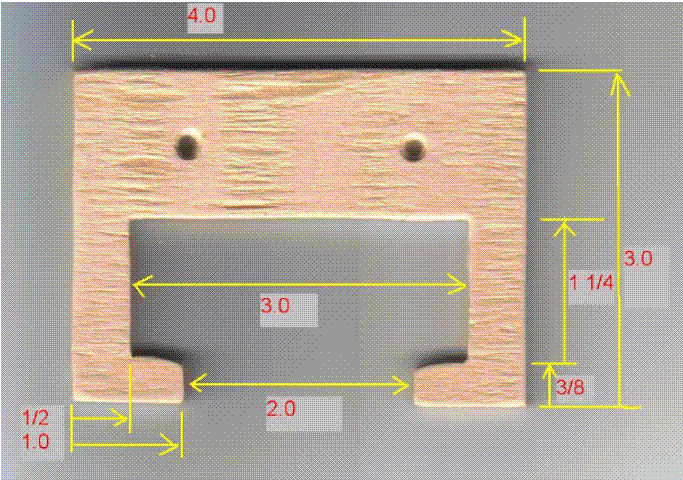Throttle Network Wiring
SUGGESTION: Sanely Working With Modular Phone Cables
Consider this choice carefully. As Digitrax points out,
terminating on screws is cheaper than RJ12 connectors. They also tell
you that terminating on screws could potentially be a rat's nest. They
are right on all accounts.
RJ12 CAN be very reliable — IF ASSEMBLED CORRECTLY! Be
sure the cable jacket is inserted into the clear body of the connector.
This is the only strain relief those frail wires will receive. If you
fail to do this, the connector will invariably get you into trouble.
If you don't trust yourself to put them together properly,
and you want to use the RJ style connector, buy them assembled.
The more I work with the wires coming out of an RJ style
cable, the more I hate them. Working with the individual wires borders
on impossible!
At the very least, buy RJ cables that have lugs already
attached. Even these easily break - right where the wire enters the
lug. Be SURE that after you are through attaching the lugs to terminals,
you clamp the cable jacket to your benchwork so there is NO stress on
the wires where they attach to the lugs. I do mean none! This is especially
important if your layout is not in a constantly climate controlled room
where corrosion could weaken the wire. They will break!
That's the general info. Now here is how I prefer
to use them.
Ideally this cable should be used with modular connectors
on both ends. AMP makes an inexpensive tool that does a
good job of crimping connectors onto the cable.
In the case of switch machine control, I need individual
wires at one end. I buy a modular jack that already has wires
coming out the back of it. They come with lugs, tinned, whatever
suits your particular need. In the case of my turnouts, I get
the tinned ends. I then Walther's Goo the modular jack to my switch
machine.

SUGGESTION (D): Greenish or Reddish Track Status Light?
If the track status light is lit, but not orange, DCC
information is being corrupted. Train operation may be erratic. See
section on Booster Wiring. SUGGESTION #3-3(D): Conserving Battery Power
Between Operating Sessions.
You are going to like this one so much
you might think this should be a recommendation!
AJ from Digitrax says, "Short the middle four wires of
LocoNet together. This will force LocoNet and the attached throttles
into idle; a low power state."
He also suggests that you use a short RJ cable to do
this and attach a red tag to it. Or paint the RJ cable red. Just plug
it into a throttle jack at the end of an operating session. Don't forget
to remove it before you begin your next operating session or nothing
will work!
What do you do with the outer two wires? Just cut them
off.
You will need to leave something on to keep idle power
on the network. Your throttle will draw power from whatever you left
on instead of the batteries. You will be able to leave the battery
in the throttle without running it down. What you leave on depends
on what system you have.
If you have a Chief set, leave the Chief DCS100 on. All
other boosters may be turned off.
If you have an LA-2: Leave the LA-2 wall transformer
on. You may turn ALL boosters off. The LA-2 will keep the command
station throttle powered up. Note: The LA-2 requires a power
connector with a 2mm barrel. The center of the barrel must be
"+".
If you have an LA-1 & it is powered by the booster
it is attached to: Leave that booster on. You may turn off all other
boosters.
Will this harm anything? No. And you need not worry about
having everything on while this special cord is plugged into LocoNet.
It is A Oookay.
Do I have to do this shorting thing? Probably. For example,
each BT2 draws 15mA when operating. This may be too much for many wall
transformers when you have more than a few throttles. In idle, it draws
100-200uA — considerably less! Even the smallest wall transformer could
keep many BT2's in idle.
AJ's right, this is easier than rigging up a switch.
Still, some of us, like myself would rather use a switch. Part of the
motivation for a switch would be turn off all the boosters at the same time.
So a relay or two may be needed. I'll include a schematic on how this
could be done 'one of these days.' In the mean time, follow AJ's suggestion.

SUGGESTION #3-5(D): Don't Torque Down the Nuts
Under the Throttle Knobs.
The optical encoders in the Digitrax throttles are soldered
firmly to the circuit board. The circuit board is held in place
by spacers. If you tightened the nuts on the throttle knobs, the
nuts will put tension on the encoder while it fights with the circuit
board and its spacers. The solder pins on the encoders may break
off.
The nuts should only be tightened just enough so that
the nut doesn't spin free and interfere with the throttle knob.
You would probably be okay to do away with the nuts.

SUGGESTION #3-6: Divide and Conquer a Short in
Your Throttle Bus
Track Wiring #5-21 has a good discussion on localizing
a short. If you used phone connectors to make your throttle
bus, you can just disconnect them rather than cut the wires.

NCE ProCab Throttle Holder by Don Vollrath
Here is my version of a simple NCE ProCab holder.
It is easy to cut out from a 1/4 or 3/8 inch piece of plywood. Round off the corners and finish with sanding filler, varnish or paint. I provided two screw holes to mount it under the layout sub-roadbed surface. The holder keeps operators from laying the throttle down on the layout.
